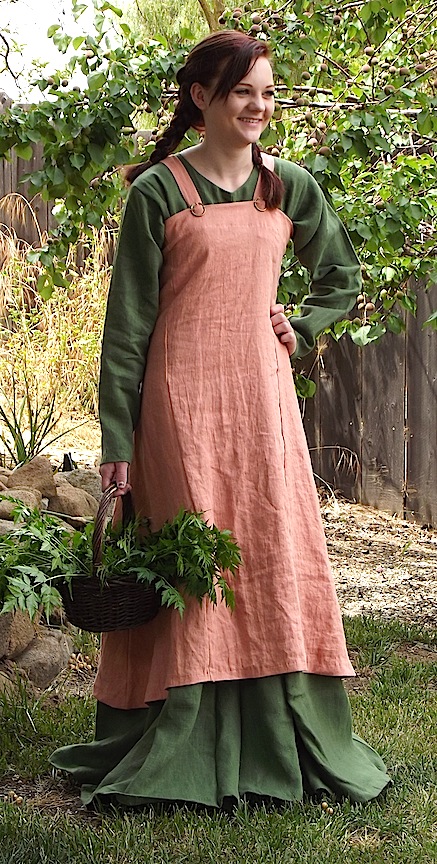By Michelle Styles
To a certain extent, it is hard to know precisely what Viking women wore and how they wore their hair. The are no portraits of Viking women and very few representations of them in statues or on coins (the usual sources for such things).
To a certain extent, it is hard to know precisely what Viking women wore and how they wore their hair. The are no portraits of Viking women and very few representations of them in statues or on coins (the usual sources for such things).
However, unlike Christians in this period, their graves can be full of grave goods but textiles are rarely preserved. Enough scraps have been found to attest that the Vikings seem to prefer bright colours and good quality cloth. It is known that sometimes cloth was given as a high status gift, particularly silk.
We know that women wore two broaches which fastened their apron dress to a long under-gown. The apron dress might or might not be pleated. Sometimes the long under gown had a train. The under gowns always seem to have gone to the floor. Given the types of cloth found, plus the fragments of looms, we know the gowns were often trimmed with embroidery or gold or silver shot ribbon.
We know that women wore two broaches which fastened their apron dress to a long under-gown. The apron dress might or might not be pleated. Sometimes the long under gown had a train. The under gowns always seem to have gone to the floor. Given the types of cloth found, plus the fragments of looms, we know the gowns were often trimmed with embroidery or gold or silver shot ribbon.
 |
| Reproduction of a Viking woolen apron dress |
Around their waist,
they often wore a chain or chatelaine where
the keys to various trunks and items used for personal grooming such as an
ear-spoon or tweezers. It is postulated that a Viking woman’s status is very
much tied to the quality of her chatelaine and the various objects which hung
from it.
We know from an Arab account about a visit to Hedeby, Viking woman wore eye make up to increase their beauty. There is some evidence that men wore eye makeup as well!

As necklaces of beads are often found in graves, we can assume that women wore beads. The beads are often imported, showing that they did help give the woman status.
On her head, she most likely wore a line head dress which tied under the chin.
In cold weather, she might a cloak with fasten on one shoulder. Depending on her status, it might be made of fur.
As the Viking Age progressed, there is evidence that women abandoned their traditional style of dress to ape the fashions of the Carolingian and later Ottoinan courts. Basically, the oval broaches start disappearing from the graves and more silver pendants are found.
Various items would hang from the belt as they did not have pockets.
Various items would hang from the belt as they did not have pockets.
For men, everyday clothing consisted of a long tunic, belted over trousers. They wore leather shoes laced up around the ankle. Any cloak would be fastened with a single broach.
The clothes were simple but functional. It was rare for cross-dressing but it could occasionally happen. For example a woman who was a shield maiden might wear masculine dress to emphasize her status. If the sagas are to be believed, when she stops being a shield maiden, she returns to female dress.
FLASH GIVEAWAY:
Michelle Styles is offering a signed copy of her latest book SAVED BY THE VIKING WARRIOR to one commentator. The winner will be chosen from the comments on Friday 22 August. Void where prohibited
Michelle Styles writes warm, witty and intimate historical
romance in a wide range of time periods, including the Viking. Her latest SAVED
BY THE VIKING WARRIOR is published today 19 August 2014.

